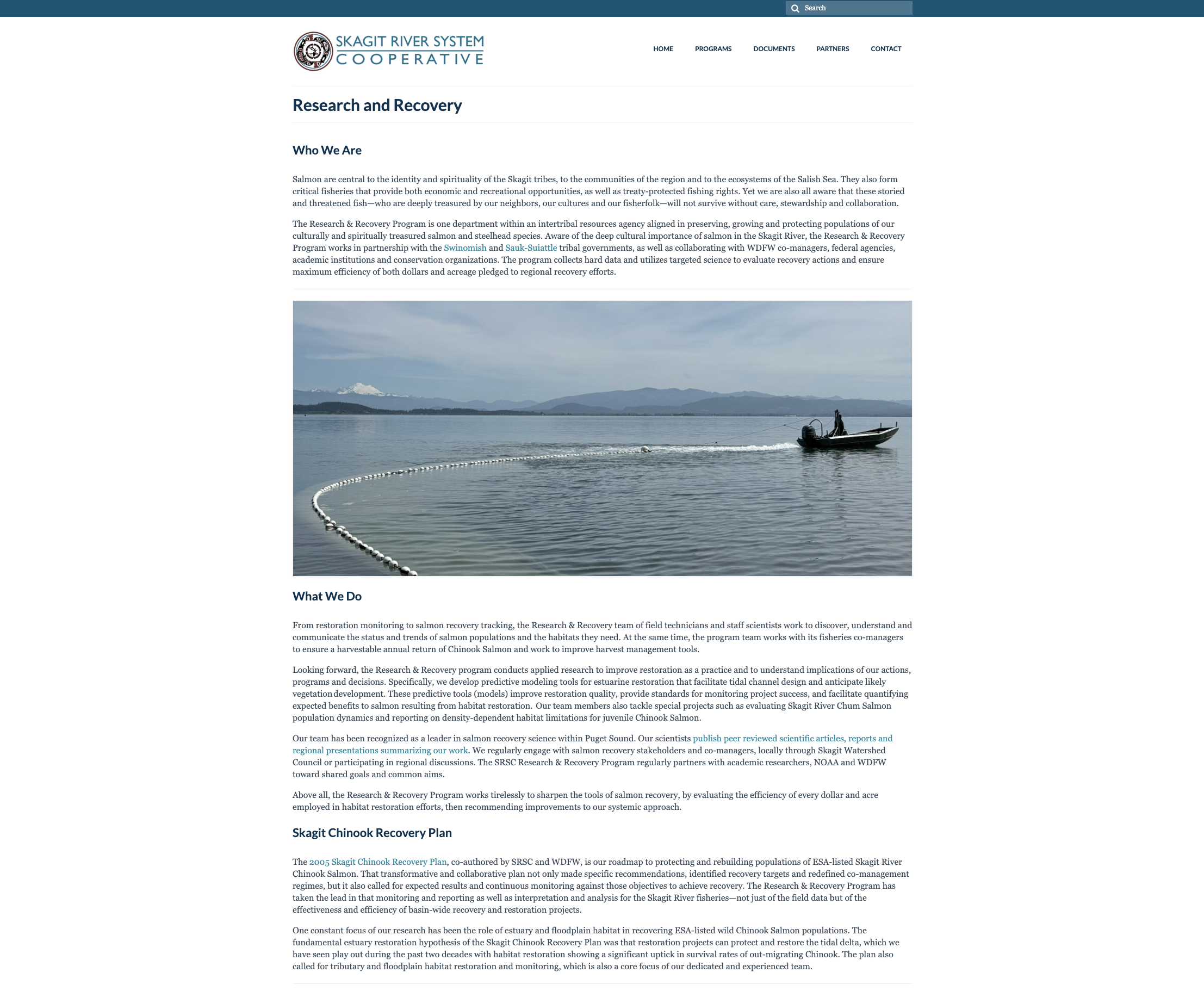Website Rewrite
Case Study Rewrite
1000+ pages of discovery
Salmon are an icon of the Skagit River valley. So when we were asked to reframe the public facing identity for the Skagit River System Cooperative—and their recovery and restoration efforts—we jumped at the change. Working closely with their program director, we dove deep into a 1,000-plus-page discovery process to truly understand the scientific work they tackle, from habitat restoration to broodstock programs. The resulting project created a compelling narrative about their work, their program, their success and their mission.
SRSC About Us Site
Who We Are
Salmon are central to the identity and spirituality of the Skagit tribes, to the communities of the region and to the ecosystems of the Salish Sea. They also form critical fisheries that provide both economic and recreational opportunities, as well as treaty-protected fishing rights. Yet we are also all aware that these storied and threatened fish—who are deeply treasured by our neighbors, our cultures and our fisherfolk—will not survive without care, stewardship and collaboration.
The Research & Recovery Program is one department within an intertribal resources agency aligned in preserving, growing and protecting populations of our culturally and spiritually treasured salmon and steelhead species. Aware of the deep cultural importance of salmon in the Skagit River, the Research & Recovery Program works in partnership with the Swinomish and Sauk-Suiattle tribal governments, as well as collaborating with WDFW co-managers, federal agencies, academic institutions and conservation organizations. The program collects hard data and utilizes targeted science to evaluate recovery actions and ensure maximum efficiency of both dollars and acreage pledged to regional recovery efforts.
Skagit Chinook Recovery Plan
The 2005 Skagit Chinook Recovery Plan, co-authored by SRSC and WDFW, is our roadmap to protecting and rebuilding populations of ESA-listed Skagit River Chinook Salmon. That transformative and collaborative plan not only made specific recommendations, identified recovery targets and redefined co-management regimes, but it also called for expected results and continuous monitoring against those objectives to achieve recovery. The Research & Recovery Program has taken the lead in that monitoring and reporting as well as interpretation and analysis for the Skagit River fisheries—not just of the field data but of the effectiveness and efficiency of basin-wide recovery and restoration projects.
One constant focus of our research has been the role of estuary and floodplain habitat in recovering ESA-listed wild Chinook Salmon populations. The fundamental estuary restoration hypothesis of the Skagit Chinook Recovery Plan was that restoration projects can protect and restore the tidal delta, which we have seen play out during the past two decades with habitat restoration showing a significant uptick in survival rates of out-migrating Chinook. The plan also called for tributary and floodplain habitat restoration and monitoring, which is also a core focus of our dedicated and experienced team.
What We Do
From restoration monitoring to salmon recovery tracking, the Research & Recovery team of field technicians and staff scientists work to discover, understand and communicate the status and trends of salmon populations and the habitats they need. At the same time, the program team works with its fisheries co-managers to ensure a harvestable annual return of Chinook Salmon and work to improve harvest management tools.
Skagit Estuary Monitoring
Washington’s Skagit River delta is a stunning and spiritual landscape, where a powerful artery flows to tidewater from its origins deep in the Cascades. The big, broad Skagit is home, not just to us, but also to all five species of Puget Sound Salmon and all species of native trout, which makes the final miles of its journey to saltwater critical habitat for these threatened species. This landscape of salty tidelands, silty side channels and expansive views provides habitat for emigrating fish to grow strong before continuing their journey to saltwater and the Pacific beyond.
Floodplain Restoration Tracking
Recognized as one of the largest salmon habitat restoration actions throughout the Puget Sound region, the Barnaby Reach project is designed to reconnect 28.9 acres of off-channel sloughs, side channels, wetlands, ponds, scroll bars, and tributary channels running between Illabot Creek to the main stem just above the confluence of the Sauk and Skagit Rivers near Rockport, WA.
Chinook Broodstock Harvesting
The journey and return of Skagit River Chinook provide both tribal and non-tribal fisherfolk with the opportunity to harvest a legendary fish in our local waters. Yet without cooperation and stewardship between SRSC and WDFW, our annual runs and returns would be a small fraction of what we anticipate each season. That is why Skagit River System Cooperative field technicians catch approximately 900 Skagit native summer Chinook Salmon on the spawning grounds each season and transport them to the Washington Department of Fish and Wildlife Marblemount Hatchery for spawning.